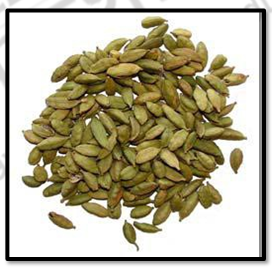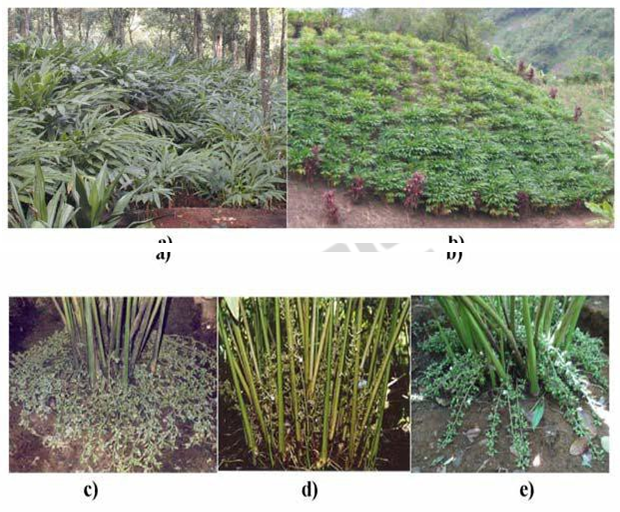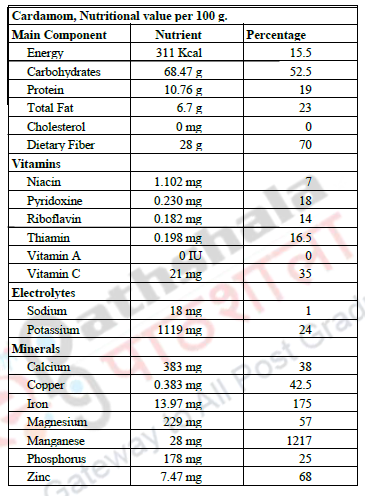17 Cardamom: Composition
17.1 Introduction
Cardamom belonging to the, family Zingiberaceae, known as the “Queen of Spices” is an important plantation crop of India. The name cardamom is used for species within three genera in the Ginger family (Zingiberaceae). One of these genera is Amomum, where the species are mainly found in Asia and Australia. Another, Aframomum, is distributed in Africa and Madagascar, and Elettaria is distributed from India to W. Malaysia.
Cardamoms are the dried fruits of perennial herbs. The seeds have a pleasant aroma and a characteristic warm, slightly pungent taste. There are two kinds of cardamoms found in the spice world: 1. True cardamom (or small cardamom) Eletteria, 2. Large cardamom, Nepal cardamom or the black cardamom belongs to the genus Amomum. Its seed pods have a strong camphor-like flavor, with a smoky character derived from the method of drying. Cardamom is perhaps the costliest among all the spices. Cardamom is often named as the third most expensive spice in the world (after saffron and vanilla), and the high price reflects the high reputation of this most pleasantly scented spice.
17.1.1 Origin and Distribution
The earliest reference to cardamom is a clay tablet from the ancient city of Nippur, Sumaria, dated 2000 BC (Weiss, 2002). Cardamoms are reportedly described in the Ayurvedic literature in India (3rd century BC), where they were recommended for stomach and urinary disorders. Cardamom was an article of trade between India and Greece during the 4th century BC. Inferior grades were known as amomon, superior ones as kardamomon, but it is still debated whether these were the same cardamoms or just those currently known as the large and small cardamom of today. References to the use of cardamom in ancient literature are scanty compared to spices like black pepper, cinnamon or cassia. Cardamom was a natural forest product until the early 19th century, and its large scale organized cultivation started only in the mid 19th century when the demand for cardamom increased worldwide.
Nowadays, India accounts for 57% of the total world production of this valuable spice. Other major cardamom producing countries are Guatemala, Tanzania and Srilanka. India’s share of supply of cardamom to world market is 52% of the total exports from all countries. Cardamom is exported in the form of dried cardamom capsule. Cardamom plantations provide employment to a large number of labourers and support many industries engaged in the post harvest technology. The total area under cardamom in the country is estimated at 93,000 hectares, which alone accounts for nearly 90% of the total world average. Production is concentrated mainly in India and Guatemala. India has been the largest producer, consumer and exporter till 1980, but afterwards its position was taken over by Guatemala. In the latter country the crop was introduced in 1920, and its production considerably expanded after World War Two due to high market prices and the drop of coffee prices.
17.1.2 Plant Description
The cardamom plant is a 2-4 m tall herbaceous perennial with branched subterranean rhizomes from which several leafy shoots arise, forming a clump. Leafy shoots have a limited life span; the first year is mainly for vegetative growth, the second year for reproductive growth (flowers and fruits), and the third year a senescence and death stage. New buds are formed from the base of the old shoots in the first and second year and thus, in a clump of old shoot. Young shoots and buds can be seen in varying numbers. Flowers are borne on erect, prostrate or semi-erect (flexuous) inflorescences depending on the variety. The leaves are lanceolate in shape, and lamina tapers into a sharp tip, 25-90 cm long and 5-15 cm wide. Leaves are dark green and shiny on the upper surface and pale green on the lower surface. The lower surface of the leaf could be smooth (glabrous) or pubescent (hairy) depending on the variety. The inflorescence arises from the base of the leafy shoots and is 45-120cm long. Flowers are borne in racemes, they are hermaphrodite, zygomorphic and about 4cm long and 1.5cm wide. The calyx is tubular green and shortly three-toothed and persistent.
The corolla tube is as long as the calyx tube, with narrow spreading pale green lobes. Flowers have an attractive petalloid labellum which is made of modified stamens, about 1.8 cm long with an undulating edge. The labellum is white in color with violet streaks radiating from the center. There is only one functional stamen which has a short, flat, broad filament, with a longer anther and connected with a short crest. The inferior ovary consists of three united carpels with numerous ovules in axile placentation and a slender style with a small capitate stigma which sits on the top to the anther along the crest. Flower initiation takes place along with the onset of the rains (March-April in India). From initiation to full bloom it takes 25 to 35 days, and from bloom to maturity, 110 to 140 days. The fruit is a trilocular capsule, ovate-globose, dark green to pale green in color. On ripening the capsule turns yellow in color; it contains 15-30 seeds which are dark brown, angled, aromatic and about 3mm long with a thin mucilaginous aril.
17.1.3 Botany
The genus Elettaria has seven species. The (small) cardamom of commerce belongs to the genus Elettaria and species cardamomum. Based on the nature of the plant, panicle, shape and size of fruits, three types of cultivated varieties can be recognized in India: var. Malabar, Mysore and Vazhukka. In the Malabar variety the plant is medium sized, 2-3m high, with leafy shoots. Generally, the leaves are hairy on the lower surface. The panicles are prostrate and 60-90 cm long: the fruits are small, globose, round or ovoid, pale green in color and are ribbed. This variety is best adapted to areas 600m to 1200m high. The variety Mysore comprises robust plants attaining 3-4m height. Leaves are large, lanceolate to oblong lanceolate and glabrous on both surfaces. Panicles are erect and capsules are bigger, longer, fusiform, three angled, dark green in color and ribbed. This variety is better adapted to altitudes between 900 and 1200m. This variety is mainly cultivated in the Indian states of Kerala and Tamil Nadu.
Fig. Cardamom growth habit and varieties: a) Cardamom under forest shade in India; b) Cultivated in open areas in Guatemala; c) Malabar with prostrate panicles; d) Mysore with erect panicles; e) Vazhukka with semi-erect panicles; f) Young plant with tillers; g) Long panicles kept circled to facilitate inter cultural operations (India).
17.1.4. Breeding
The basic chromosome number of Elettaria is x =12 and the somatic chromosome number is 2n= 48 or 52. Cardamom is cross-pollinated, and a large variability exists in seedling progenies. Germplasm is collected and maintained at various research institutes, such as the Research Institute for Spices and Medicinal Plants in Bogor, Indonesia; the Indian Institute of Spices Research (IISR) at Calicut; and the All India Coordinated Research Project on Spices (AICRPS).
Selections and hybrids have mainly been made for yield improvement and resistance to pests and diseases. Plants with medium stature and prostrate panicles are more suited for closer planting and (3000 plants per hectare), whereas robust plants with semi-erect panicles are suited for low density planting and intensive management practices (1000 plants/ha). Hence, quite a number of location- specific varieties have been released in various countries, many of which yield more than 1000 kg /ha.
17.1.5. Ecology and Growing Conditions
Cardamoms are shade loving plants; overhead shade is generally provided by forest trees. They grow well in places receiving a well distributed rainfall throughout the year, and with temperatures ranging between 10° and 35° C. In India cardamom is cultivated at altitudes between 700m and 1500 m along the Western Ghats with an annual rainfall 1500-3000mm. In Sri Lanka growth concentrates mainly at altitudes above 1,000 m. Cardamom cultivation is mainly rain-fed and depends largely on the monsoon rains. In areas where, due to climatic change phenomena, rains have become less predictable and temperatures are increasing, over-head sprinkler irrigation may become necessary. In Guatemala, cardamom growing areas receive about 2,000 to 5,000 mm rainfall per annum, and the rainfall is generally well distributed over 170 to 200 days in a year. Average temperatures are cooler than in India and Sri Lanka. Cardamoms prefer well drained soils rich in organic matter; the crop does not tolerate water logging. Most suitable cardamom soils have sandy clay to sandy clay loam texture, and are acidic in nature (pH 4.5-5.8); these soils are often deficient in zinc, boron, molybdenum and manganese
In India, Kerala is the largest producer of the cardamom crop. In Kerala the major cardamom growing zones are (a) Udumbanchola taluka (b) Peeremedu taluka and (c) Devikulam taluka. Karnataka is one of the main areas where cardamom cultivation is seen. In Karnataka, Shimoga district is one of the main areas where cardamom cultivation can be found. Koppa, Sringeri, NR Pura, Siddapur, Yellpur, Joida, Sagar, Thirthahalli and Hosanegare are the main areas in the district where large‐scale cardamom cultivation can be seen. In Shimoga, approximately 5850 hectares of area is under cardamom cultivation. Of these, yielding area of cardamom comes only 4310 hectares. Total area under cardamom in the state is 55,000 hectares. Area under Cardamom cultivatio was around 94.3 thousand hectares in 1997‐98. This reduced to 84.8 thousand hectares in 1999‐2000. It increased to 95.6 thousand hectares in 2003‐04 and was 98.2 thousand hectares in 2006‐07.
Cardamom fruits ripen over an extended period and are harvested every 3-5 weeks. There are maturity differences between cultivars. Fruits are individually picked with their pedicels when they are fully developed but unripe. Some cultivars change colour as they mature while others do not and local experience is necessary to judge the correct harvest time. After harvest, capsules are washed thoroughly in water to remove adhering soil. A pre- soaking of the capsules in hot water at 40°C and dipping the capsules for 10 minutes in a 2% sodium carbonate solution helps increase the green colour of the capsules
Though the area under cultivation has remained almost stable, the production has increased because the productivity of cardamom has improved a lot in the domestic front i.e. from the low level of 106 Kg/Hectare yield in 1998‐99 to 186 Kg/Hectare in 2005‐06. Though this data is average yield, some of the plantations produce 1000‐1500 Kg per hectare regularly. The yield in the recent years, however, has started increasing albeit slowly with increase in use of better planting materials by innovative cardamom growers and installation of drip irrigation systems.
The “queen of spices” is rich in medicinal value. The seeds of cardamom are aromatic, masticatory, cooling, pungent, cardiac tonic, stomachic, laxative, diuretic, carminative, abortifacient and antidotal; they are useful in asthma, bronchitis, piles, diseases of the bladder, kidneys, liver, uterus, rectum and throat, scabies, headache, ear ache, and toothache, they create thirst and lessen inflammation; as a diuretic the seeds are given with honey or whey Cardomom seeds are useful for flatulence but they are usually used as adjuvants with other remedies. They are also used as a spice in cooking and as flavouring in other medicines. The Nepal cardamom (Amomum subalantum) is considered to be useful as a tonic for heart and liver. Decoction of the seed for gargling is useful in the infections of teeth and gums. It is also an aromatic stimulant and remedial on stomachache.
The Lesser Cardamom (Elletaria cardamomum) Moten and tinctures of cardamom are useful as medicines. Ground cardamom seeds with ginger and cloves an caraway (Carum carvi)is helpful in combating digestive ailment, sore throat, hoarseness, during the infective stage of influenza. Therefore, it is rightly said that eating a cardamom once a day with a table-spoonful of honey improves eye-sight, strengthens nerves and keeps one healthy. The cardamom is so called as “a poor man’s rich spice”.
17.2 Types of cardamom
There are two main types of cardamom:
- Small green cardamom (Eletteria cardamomum)
- Large red/black cardamom (Amomum subulatum Roxb)
The most common type is the small green cardamom while large cardamom is mainly grown in India, with some in Nepal and Bhutan. They both come from the Zingiberaceae family of plants.
17.3 Chemical Composition of Cardamom
Cardamom contains 2.8–6.2% volatile oil, approximately 10% protein, 1–10% fixed oil, up to 50% starch. The volatile oil is composed mainly of α-terpinyl acetate and 1,8-cineole, each of which may be present at concentrations of up to 50% or more; lesser components include limonene, sabinene, linalool, linalyl acetate, α- pinene, α-terpineol, camphene, myrcene, 1,4-cineole, borneol, and others. Acid constituents of the oil include acetic, butyric, decanoic, dodecanoic, citronellic, geranic, hexanoic, heptanoic, nerylic, and perillic acids. The fixed oil mainly consists of waxes containing n-alkanes and sterols, including β-sitostenone, stigmasterol, and β- sitosterol. The essential oil in the seeds contain a-terpineol 45%, myrcene 27%, limonene 8%, menthone 6%, ß- phellandrene 3%, 1, 8-cineol 2%, sabinene 2% and heptane 2%.Compositions of oils vary, depending on types (e.g., Mysore and Malabar). Oils containing a low content of cineole but high content of terpinyl acetate are considered to be of superior quality for flavor applications. Cardamom is rich in vitamin C, thiamine, riboflavin, niacin, vitamin B6, zinc, copper, iron, sodium, manganese, potassium, calcium, magnesium, phosphorus respectively.
| you can view video on Cardamom Composition FT |




